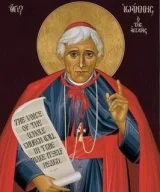Our own Ordinariate Pilgrim, Scott Anderson, has added some ideas to the growing collection of postings on Ordinariate-related sites about the English (Gothic) Use and the Baroque style and about the use of Anglican-type attire:
“English Use or Roman Use: it was a live question when I was a server in the 60′s, and we certainly knew the difference! There were two churches in the town, and both would have described themselves as ‘Anglo-Catholic’ but one was ‘English’ and the other was – well, I suppose that it would have called itself ‘Western’, because we didn’t want to disturb those members of the congregation who were not quite up on all of this. It all sounds rather petty now, and perhaps we servers ought to have been fussing about rather more important things. Yet as the Ordinariate moves towards a Eucharistic Liturgy of its own, to be used alongside the current Missal, perhaps we might consider how this Liturgy is to be performed. We are talking about ceremonial but more than that, the ethos of worship. Is there something distinctively English, and should the Ordinariate develop it. Certainly we young servers knew how to distinguish between ‘English’ and ‘Roman’?
The moment you walked into the church and looked at the altar, you knew. The ‘English’ altar had two candles, a frontal (sometimes curtains called ‘riddels’ on three sides) and often two standard candlesticks on the sanctuary pavement of the High Altar.
Now if you walked into a ‘Roman’ or ‘Western Use’ church, the altar would have looked quite different. Six candles (at least) standing on a shelf (a ‘gradine’) and a lofty reredos and lots of steps. Notice as well that the Blessed Sacrament in the ‘English Use’ is in a small aumbry (cupboard) to the left of the altar, and in the ‘Roman Use’ is in a large tabernacle in the centre of the altar.
In both churches the vestments would have been worn at the Eucharist, but the shape was very important: ‘English Use’ was full and flowing, ‘Roman Use’ was cut away at the sides and stiffened so that the chasuble hung flat. Both vestments were chasubles, but one the shape of the English Middle Ages, and the other from the Continent of the 18th century.
Notice that the priest in the English Use vestments is bare-headed in church, whereas the Roman Use Celebrant wears the biretta on his head. The alb (the long white undergarment) is trimmed with lace, and this was also a distinguishing feature. In Roman Use churches albs and cottas, as well as altar cloths, were often trimmed with lace of varying quality. In English Use churches lace was never used.
Both the cotta and the surplice are derived from the alb, and came to be worn in the Middl e Ages in place of the alb for the Choir Offices, and for Baptism and Marriage outside the Mass.
The long full surplice was increasingly shortened in Counter-Reformation Europe and decorated with lace.
In the Church of England the surplice continued in its mediaeval form through the same period, though it was sometimes made to open at the front to accomodate the full-bottom wigs worn by men at the time. This custom of wearing wigs also debased the shape of the hood worn by English academics and clergy, so that the modern strip of black and coloured silk worn by students at ther graduation bears little resemblance now to any sort of ‘hood’. In the illustration from the “Parson’s Handbook” the priest wears a full surplice, an academic hood of his university, made in the original shape before the use of wigs altered it, and the black scarf. This is often wrongly called a ‘preaching scarf’, for it is part of choir dress and has nothing to do with the pulpit! Dearmer maintains that it is the mark in choir of the clerk in holy orders, when lay clerks too would have worn the surplice and hood. He mischievously points out that, in abandoning the scarf, ‘Roman Use’ Anglicans have abandoned a priestly vestment. I do not know whether he is right or not!
Servers in English Use churches often wore the alb at the Eucharist, and their amices (and those of the clergy) had a strip of stiffened coloured fabric sewn on to the edge. This ‘apparel’ formed a collar, as can be seen in the picture below. Notice that the alb skirts and the cuffs are also decorated with coloured apparels. The Sacred Ministers wear full vestments, and the altar is long and low, with two candles only on the altar. Posts with angels holding four more candles support curtains on the east, north and south sides. There appears to be a fourth minister: in the English Use there might be one or two ‘clerks’ who would wear tunicles similar to that of the ‘subdeacon’ (the third minister who sang or read the Epistle) and would carry the Processional Cross and generally assist at the altar. (This custom of servers wearing tunicles was not unknown on the Continent. A little book called ‘Ceremonial Curiosities’ written by an Anglican cleric in the early 20th century, tells how he watched the acolytes in a Spanish Cathedral carry their candles over their shoulders, with streams of molte wax pouring down the back of the magnificent embroidered tunicles they were wearing)
In this exquisite mediaeval painting, St Martin celebrates Mass assisted by a deacon. Both ministers wear very full vestments, with apparels on the amice and alb.
The battle of ‘Roman’ v ‘English’ largely faded out from the 1970′s on. As a result of the liturgical renewal of the Second Vatican Council Catholic altars were stripped of their gradines and rows of towering candlesticks. ‘English altars’ lost their curtains as they were moved forward to allow the Celebrant to ‘face the people’. Lace went out of fashion, cottas grew in length to outdo surplices, and polyester albs saved on the washing and ironing for clergy and servers alike.
But the pendulum swings, and with wider permission to use the Extraordinary form of Mass (the 1962 revision of the so-called ‘Tridentine’ Rite) fiddleback vestments, lace albs and birettas are to be seen again in the Catholic liturgy. This may pose something of a dilemma as the Ordinariate develops its liturgical forms. Most (though not all) of us in the Ordinariate are from an Anglican background which has made a point of using ‘Western’ (Roman) ceremonial, and especially since the 1970 missal was published.
But if the Ordinariate is to be distinctive in at least some of its forms, would it not make sense to think about ‘clothing’ the rites which are in preparation with the simple beauty of the ‘English Use’ which some of us knew in former years? Certainly the assumption that the Ordinariate Rites should be celebrated in 18th century Continental vestments and with the ceremonial of the pre-conciliar Roman Rite does not seem particularly logical.”


















